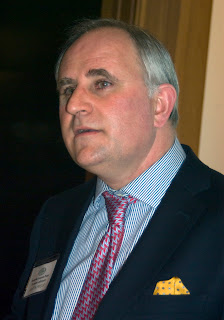Stéphane Aviron, Potel-Aviron (Photo ©Tom Hyland)
The Frederick Wildman Burgundy event came to Chicago last week and I was there, tasting new releases of white and red Burgundy - including Beaujolais - from the 2010 vintage. I rarely get the chance to taste many Burgundies, so what a wonderful opportunity to taste more than 50 examples of these wines at one setting.
How is the vintage shaping up? Very well, indeed; although chances are you haven't heard much about it. The primary reason for that is because of the press that has surrounded the wines from 2009. That was a warm year and produced Burgundies that are ripe and rich - in some cases even a bit fat - that certain influential wine critics believe are outstanding wines. To each his own, but quite often these flashy wines that offer early appeal don't have the proper structure for long term aging.
Weather-wise, 2010 was a year of no big surprises in Burgundy and produced wines that have excellent acidity and structure. Listen to what Stéphane Aviron from Potel-Aviron, an outstanding Beaujolais producer has to say about his 2010 wines. "With 2010, we can find the difference among the various cru much better than we could in 2009. The wines are much more typical."
Franck Grux, Domaine Olivier Leflaive (Photo ©Tom Hyland)
Franck Grux of Domaine Olivier Leflaive also had some excellent comments about the 2010 Burgundies. "The grapes were slow to mature, resulting in ideal acidity. These are the best balanced wines we have seen since 1990."
As for highlights at the tasting, there were quite a few, beginning with the white wines from Domaine Vincent from the Macon. Their Pouilly-Fuissé "Marie-Antoinette" is a charming wine with attractive apple and pear fruit and lively acidity, while their estate Pouilly Fuissé "Les Brulés", offers more depth of fruit as well as beautiful aromas of vanilla and spiced pear. The entire range of Pouilly-Fuissé from this producer has been quite impressive for many years now and their excellence is once again on display with the 2010s.
Of course, one would expect nothing but the finest white wines from Olivier Leflaive. Among the finest wines from this producer included the Chassagne-Montrachet "Clos Sant-Marc" with impressive concentration and beautiful varietal purity along with the Puligny-Montrachet "Champs-Gain", that is fuller than the Chassagne and also features lovely quince and lemon oil perfumes.
Various offering of Chablis from Christian Moreau were also poured; the best I tasted were the "Les Clos" which has a distinct minerality and very good acidity and the "Valmur" which is riper and more intense than the "Les Clos."
As for the reds, let's start with the Beaujolais from Potel-Aviron. The Chenas, from vineyards planted in 1930, is quite rich with moderate tannins and can be enjoyed for 5-7 years. The Moulin-a-Vent is a bit richer, as one might expect and has very good acidity. But the most impressive is the Morgon "Cote de Py" which is from a site that is a former volcano. This is very rich for a Beaujolais and offers tantalizing wild strawberry fruit as well as excellent persistence; it's a great Beaujolais!
Martin Prieur, Domaine Jacques Prieur (Photo ©Tom Hyland)
Another excellent Beaujolais was the Moulin-a-Vent "Les Clos" from Domaine Labruyeré, a small project of Domaine Jacques Prieur. This Moulin-a-Vent vineyard is 75 years old and is located just under the famous windmill that gives its name to this cru. Full-bodied with ripe cherry and raspberry fruit, this is tightly packed with layers of fruit and will demand at least 2-3 years of aging before it reveals all its excellence.
Notable reds from Prieur included the Beaune "Champs-Pinot" a ripe and rather meaty version of this cru along with the powerful Corton-Bressandes and of course, the Clos Vougeot, offering excellent depth of fruit along with exotic wild strawberry and cassis fruit.
Finally, a few highlights from Armand Rousseau. The straight Gevrey-Chambertin has lovely perfumes and excellent persistence, while the Clos de la Roche has intense aromas of bacon (I love it!) and cherry with a powerful finish with excellent persistence. Then there is the Chambertin, a wine of amazing concentration and complexity that has enough fruit to stand up to all the new oak. This will need a lot of time to show its true potential - I estimate the wine will be at its best in 20-25 years - but this is truly in a class by itself!




No comments:
Post a Comment